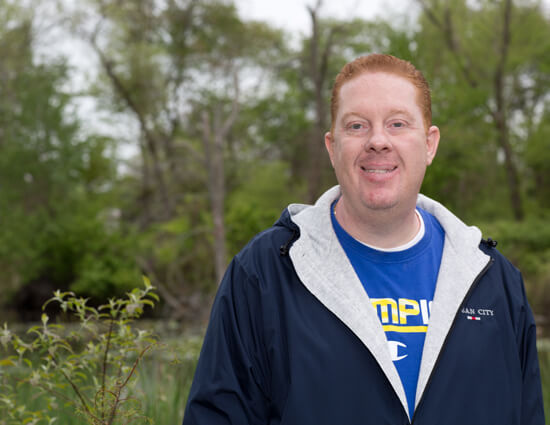“I’ve learned you never give up”

After suffering stroke, Anthony is feeling more like himself—and thankful
In one moment, life can take us on a completely new path.
Anthony, a Yardville resident, experienced one of those moments when he suffered a serious stroke. Anthony went from giving his brother a hand one second, to his brother reaching his hand out to help Anthony the next.
The First Hour
“It happened so fast,” Anthony recalls, having pieced together the memory from his family’s recollection of the day. “First, I couldn’t see, and then my whole right side went weak.”
His brother knew instantly this could be a stroke. He called their sister, a nurse, and confirmed his fear. The next call was 9-1-1, and Anthony was taken by ambulance to the hospital.
Anthony’s brother and sister helped the emergency team determine what was happening by providing a timeline and list of symptoms. He was immediately sent for a CT scan and a neurology consultation.
Jennifer, Anthony’s wife, met him at the emergency department. “He was slurring his words pretty badly and his entire right side wouldn’t budge at this point,” she recalls.
According to Lasanta Horana, MD, medical director of the emergency department, a case like Anthony’s is instantly called a “code stroke,” and a team is mobilized for the patient’s arrival.
“Upon entering the ED, we immediately take the patient to a bed where he is seen by a team of nurses and an ED physician,” Dr. Horana explains.
“We perform a thorough neurological exam including a NIH stroke scale, we obtain a head CT scan, EKG, and blood work, and begin a teleneurology consult where you are able to talk and interact with a stroke neurologist right away,” he says.
Jennifer remembers how quickly all of this occurred. “They were able to put him in front of a neurologist so fast using the [teleneurology] equipment in the ER,” Jennifer explains. “[The neurologist] talked to him, reviewed the information and did some tests to confirm it was a stroke shortly after he arrived.”
Time = Brain
To understand what was happening to Anthony, it’s important to understand stroke. There are two types of stroke:
- Ischemic – a blockage of blood flow to parts of the brain, often caused by blood clots
- Hemorrhagic stroke – a blood vessel rupture and bleeding takes place in the brain
Anthony experienced an ischemic stroke. A blood clot had traveled into the vessels delivering blood to the brain and caused a blockage in the flow.
“In the ischemic stroke, the brain tissue starts to show changes, beginning soon after the blockage,” explains Rao Pasupuleti, MD, board certified neurologist and medical director of RWJ Hamilton’s Primary Stroke Center.
- Symptoms of stroke include:
- Numbness and weakness, often on one side
- Dizziness
- Slurred speech
- Visual disturbance
- Facial drooping
“As soon as the blockage occurs, the nerve cell function is deranged, and eventually they begin to die. This is why it is essential to seek care immediately if there is any concern for stroke,” he says.
tPA to the Rescue
Within an hour of his first symptom, Anthony was given a life-saving—and brain-saving—dose of tPA, a “clot-busting” drug used to restore critical blood flow in the brain.
Again, in one moment, Anthony's life changed. With the help of the tPA, his emergency team and his family, Anthony was on another new path--one to recovery.
The field of medicine has made so many advances in the past two decades—with tPA being arguably one of its biggest successes.
“Studies have shown that patients with ischemic strokes who received tPA are more likely to recover fully or have less disability than patients who do not receive the drug,” explains Dr. Horana.
RWJ Hamilton’s stroke program participates in the American Heart Association/American Stroke Association Target: Stroke initiative aimed at improving the quality of stroke care across the country.
“The core of the stroke is a point at which the stroke is most damaging,” explains Dr. Pasupuleti. “At the core, much of the damage can be irreversible. However, there is also a peripheral area of the stroke called the penumbra. In this area surrounding the core stroke, intervention can help the nerve cells to survive.”
“Salvageable tissue can be saved if we can use tPA in enough time—within 4.5 hours—and the sooner the better. Our goal with Target: Stroke is to administer the tPA within one hour of arriving to the ER, and we are doing quite well meeting that measure,” Dr. Pasupuleti says.
Anthony has come a long way since his stroke occurred. He’s recovered his speech fully, walks without assistance and continues to strengthen his right side at ongoing physical and occupational rehabilitation sessions with RWJ’s rehab team.
“I’ve learned you never give up,” he says. “Even when you think you’re as good as you’re going to get, there’s always room for improvement.”